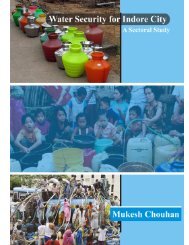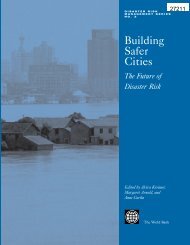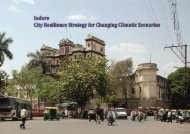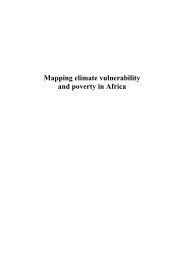Climate Change and Local Level Disaster Risk Reduction Planning ...
Climate Change and Local Level Disaster Risk Reduction Planning ...
Climate Change and Local Level Disaster Risk Reduction Planning ...
Create successful ePaper yourself
Turn your PDF publications into a flip-book with our unique Google optimized e-Paper software.
such elaborate frameworks. This calls for a simpler framework, which could go as a subset of<br />
these sophisticated frameworks, for local level disaster managers <strong>and</strong> policy making personnel. In<br />
this section, we provided a simple framework for mainstreaming climate change concerns in local<br />
level disaster risk management process.<br />
We propose that, for any mainstreaming to happen, it is important for the local disaster risk<br />
managers <strong>and</strong> other stakeholders to underst<strong>and</strong> what national <strong>and</strong> regional climate change<br />
assessments mean for the scales at which these personnel operate. Because these personnel work<br />
at local scale (city, group of villages etc) <strong>and</strong> often lack the perspective of climate <strong>and</strong> long-term<br />
implications of climate change, it is essential that a local <strong>Climate</strong> Task Group (CTG) is<br />
established. The CTG should consist of personnel from disaster risk management, climate <strong>and</strong><br />
atmospheric <strong>and</strong> policy making domains (O’Brien et al, 2006). Such a group is necessary as the<br />
disaster management personnel alone cannot obtain <strong>and</strong> infer the often challenging climate<br />
information available from global <strong>and</strong> regional climate change studies <strong>and</strong> reports. However, the<br />
required personnel may not always be available at the administrative scale under consideration<br />
(e.g. small <strong>and</strong> medium cities <strong>and</strong> institutions). Under those circumstances, cross-scale<br />
collaboration becomes necessary. There may be similar groups existing for monitoring drought<br />
or flood conditions, similar to the Drought Monitoring Center established in Karnataka State of<br />
India or Flood Management Boards in Vietnam which are provided with capacities to assess <strong>and</strong><br />
monitor local drought <strong>and</strong> flood situations (Imamura <strong>and</strong> To, 1997; Samra, 2004). These Centers<br />
<strong>and</strong> Boards could form a good beginning as they have capacities such as data processing that are<br />
relevant for the operation of CTG. In addition to its role in disaster risk reduction planning, the<br />
CTG can also play a vital role in integrating disaster <strong>and</strong> climate risk reduction aspects in<br />
developmental planning as well. For example, the representative of CTG could be a member in<br />
local level development committees similar to the District Development Committees <strong>and</strong> Village<br />
Watershed Committees established in India. Such integration would enable free flow of<br />
information.<br />
The next step is to identify the region’s vulnerabilities <strong>and</strong> how climate change may influence<br />
those vulnerabilities (Thomalla et al, 2006). This brings the crucial need for identification of<br />
12









